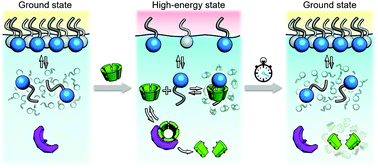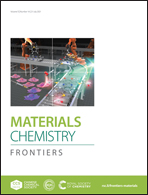A transient high-energy surface powered by a chemical fuel†
Abstract
A common practice to regulate surface energy (γ) depends on stimuli-responsive surfactants that switch between active and inactive forms; this equilibrium-based strategy is, however, binary in origin and difficult to regulate in the time domain. Here, we leverage nonequilibrium chemistry to construct an aqueous system that can be transiently excited to a high-energy state by a chemical fuel before relaxation to the ground state. Specifically, this system embodies three elements—a surfactant to change γ, a fuel (cyclodextrin) to deactivate the surfactant, and a fuel burner (amylase) to enzymatically consume the fuel—that are mutually dependent as governed by an equilibrium-reaction coupling. Combining experimental measurements and theoretical modelling, we showcase the regulatory capacity of this nonequilibrium strategy by finely tuning the excitation-relaxation behavior and by further actively shaping the temporal profiles of γ into arbitrary forms including staircase-like (de-)escalation and a sinusoidal wave. Given its application-friendly nature, we successfully implement this strategy in wetting, capillarity, and weight support, and we expect its easy adaptability in a wide range of surface/interface-involved scenarios such as emulsification, foaming, and liquid transportation.

- This article is part of the themed collection: Bio-inspired Interfacial Materials and interfacial Chemistry


 Please wait while we load your content...
Please wait while we load your content...